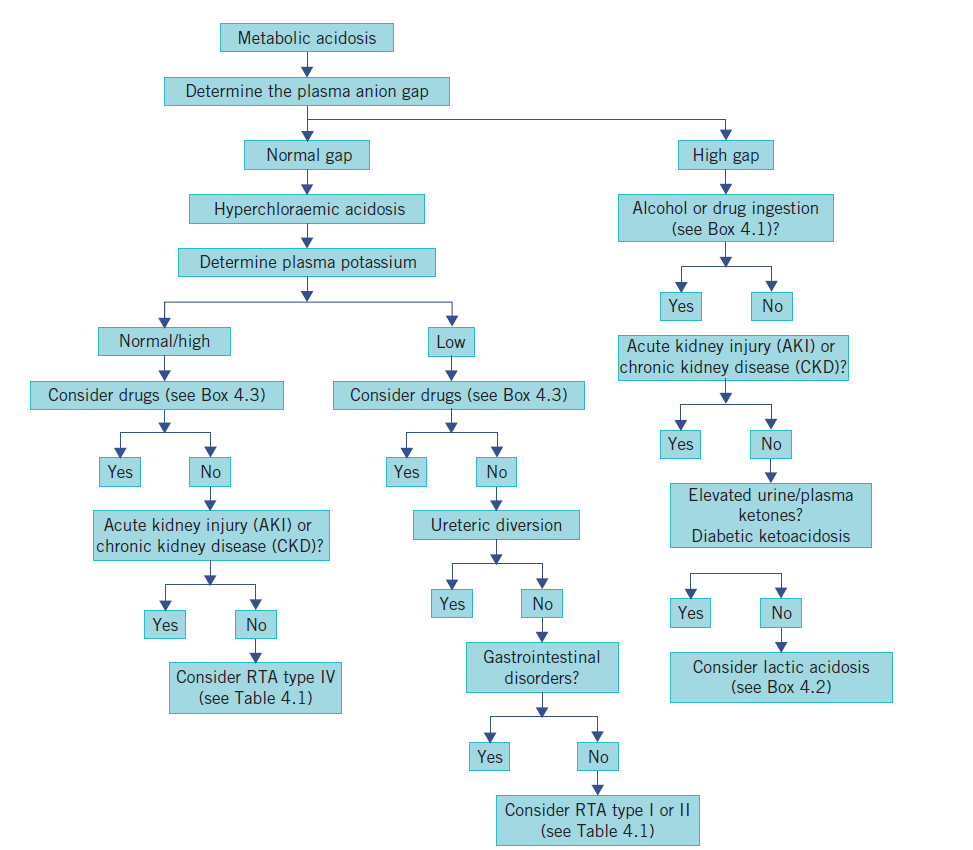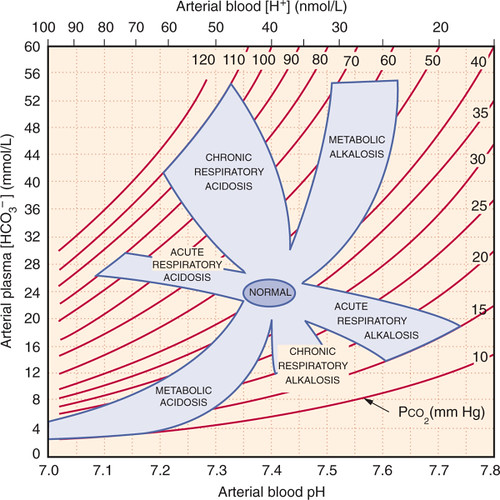Makindo Medical Notes"One small step for man, one large step for Makindo" |
|
|---|---|
| Download all this content in the Apps now Android App and Apple iPhone/Pad App | |
| MEDICAL DISCLAIMER: The contents are under continuing development and improvements and despite all efforts may contain errors of omission or fact. This is not to be used for the assessment, diagnosis, or management of patients. It should not be regarded as medical advice by healthcare workers or laypeople. It is for educational purposes only. Please adhere to your local protocols. Use the BNF for drug information. If you are unwell please seek urgent healthcare advice. If you do not accept this then please do not use the website. Makindo Ltd. |
Metabolic acidosis
-
| About | Anaesthetics and Critical Care | Anatomy | Biochemistry | Cardiology | Clinical Cases | CompSci | Crib | Dermatology | Differentials | Drugs | ENT | Electrocardiogram | Embryology | Emergency Medicine | Endocrinology | Ethics | Foundation Doctors | Gastroenterology | General Information | General Practice | Genetics | Geriatric Medicine | Guidelines | Haematology | Hepatology | Immunology | Infectious Diseases | Infographic | Investigations | Lists | Microbiology | Miscellaneous | Nephrology | Neuroanatomy | Neurology | Nutrition | OSCE | Obstetrics Gynaecology | Oncology | Ophthalmology | Oral Medicine and Dentistry | Paediatrics | Palliative | Pathology | Pharmacology | Physiology | Procedures | Psychiatry | Radiology | Respiratory | Resuscitation | Rheumatology | Statistics and Research | Stroke | Surgery | Toxicology | Trauma and Orthopaedics | Twitter | Urology
Related Subjects: |Metabolic acidosis |Aspirin or Salicylates toxicity |Ethylene glycol toxicity |Renal Tubular Acidosis |Lactic acidosis |Metabolic alkalosis
🧪 Analysis of Metabolic Acidosis (ABG)
- pH < 7.35 (unless compensated).
- HCO₃⁻ < 22 mmol/L.
- PaCO₂ usually low (<5.3 kPa) due to respiratory compensation (hyperventilation).
- PaO₂ often normal.
- Base Excess < -2.
⚡ Aetiology
- Accumulation of organic or inorganic acids.
- Loss of bicarbonate (HCO₃⁻).
- Anion Gap (AG) = (Na⁺ + K⁺) – (Cl⁻ + HCO₃⁻). Normal = 8–12 mmol/L.
📊 Causes by Anion Gap
| 🔺 High Anion Gap | ➡️ Normal Anion Gap |
|---|---|
|
|

🧠 Clinical Features
- Hyperventilation (Kussmaul breathing).
- Underlying cause often obvious (shock, DKA, diarrhoea etc.).
- AG helps narrow differential.
🔎 Key Anion Gap Markers
| Anion | Clinical Case |
|---|---|
| 🧪 L-Lactate | Anaerobic metabolism (shock, sepsis). |
| 🍩 Beta-hydroxybutyrate | Diabetic ketoacidosis. |
| 🧴 Hippurate | Toluene poisoning (glue sniffers). |
| 🥛 Glycolate & Oxalate | Methanol/ethylene glycol ingestion. |
| 🌿 D-Lactate | Gut fermentation (e.g., blind loop syndrome). |

💊 Management by Cause
| Cause | Clinical Features | Diagnostic Tests | Management |
|---|---|---|---|
| 💉 Lactic Acidosis | Shock, sepsis, hypoxia, confusion, tachypnoea. | ABG (low pH/HCO₃⁻), serum lactate ↑. | Oxygen, IV fluids, treat cause, inotropes (noradrenaline if septic shock). |
| 🍩 Ketoacidosis | Polyuria, polydipsia, fruity breath, dehydration, confusion. | ABG (low pH, low HCO₃⁻), ketones ↑, glucose ↑ (DKA). | IV fluids, insulin infusion (if DKA), K⁺ replacement, monitor glucose & ketones. |
| 🩺 Renal Failure | Oedema, oliguria, confusion, uremia. | Creatinine ↑, urea ↑, ABG acidosis, electrolytes (hyperkalaemia). | Dialysis if severe, correct underlying cause, treat K⁺ imbalance. |
| ☠️ Toxins | Visual loss (methanol), renal failure (ethylene glycol), tinnitus (salicylates). | ABG: HAGMA, osmolar gap ↑, toxin assays. | Fomepizole, dialysis, bicarbonate (salicylates). |
| 💩 Diarrhoea | Loose stools, dehydration, cramps, lethargy. | ABG: NAGMA, low K⁺, low Na⁺. | Rehydrate (oral/IV), replace electrolytes, treat cause (infection, malabsorption). |
| ⚡ Renal Tubular Acidosis | Polyuria, weakness, bone pain, growth delay (children). | ABG: NAGMA, urine pH pattern, electrolytes. | Oral bicarbonate (NaHCO₃ or K-citrate), treat cause. |
| 🧂 Hyperchloremic Acidosis | Weakness, confusion, oedema if fluid overload. | ABG: NAGMA, Cl⁻ ↑, HCO₃⁻ ↓. | Stop saline infusion, use balanced fluids (Hartmann’s/Ringer’s), correct electrolytes. |
🩺 Case 1 — Diabetic Ketoacidosis (DKA)
A 24-year-old woman with type 1 diabetes presents with abdominal pain, vomiting, and drowsiness. Vitals: HR 120, BP 95/60, RR 28 with Kussmaul breathing. Labs: glucose 28 mmol/L, ketones 6 mmol/L, pH 7.15, HCO₃⁻ 10 mmol/L. Management: 💉 Fixed-rate IV insulin infusion, IV fluids (0.9% saline initially), potassium replacement as guided, identify trigger (infection). Avoid: ❌ Bicarbonate therapy unless pH <6.9; avoid rapid fluid shifts in young patients (risk of cerebral oedema).
🩺 Case 2 — Lactic Acidosis in Sepsis
A 68-year-old man presents with fever, hypotension, and confusion. BP 80/50, HR 120, lactate 6.2 mmol/L, pH 7.22, HCO₃⁻ 14 mmol/L. Diagnosis: septic shock with lactic acidosis. Management: 🚑 Sepsis 6 bundle — IV fluids, broad-spectrum antibiotics, oxygen, source control. Consider vasopressors if hypotension persists. Avoid: ❌ Delaying antibiotics; avoid excessive normal saline (can worsen acidosis with hyperchloraemia).
🩺 Case 3 — Renal Failure (Uraemic Acidosis)
A 75-year-old woman with stage 5 chronic kidney disease presents with progressive weakness, nausea, and confusion. Labs: pH 7.28, HCO₃⁻ 16 mmol/L, high urea and creatinine, potassium 6.0 mmol/L. Management: 🩺 Sodium bicarbonate therapy if symptomatic and not fluid overloaded, treat hyperkalaemia, dialysis if severe or refractory. Avoid: ❌ Relying on IV fluids alone; avoid potassium-sparing drugs (e.g. spironolactone, ACEI) in the acute setting.